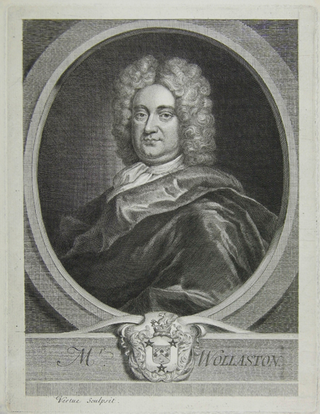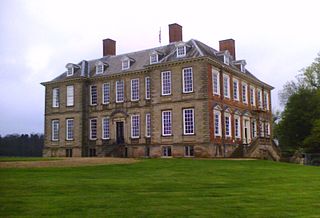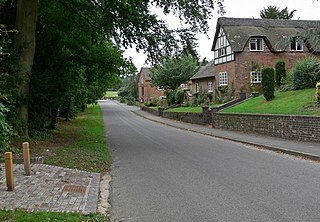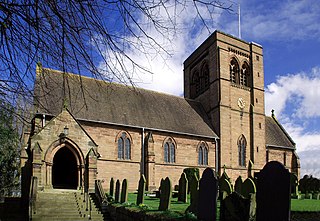
William Wollaston was a school teacher, Church of England priest, scholar of Latin, Greek, and Hebrew, theologian, and a major Enlightenment era English philosopher. He is remembered today for one book, which he completed two years before his death: The Religion of Nature Delineated. He led a cloistered life, but in terms of eighteenth-century philosophy and the concept of natural religion, he is ranked with British Enlightenment philosophers such as Locke, Berkeley, and Hume.

Stanford Hall is a stately home in Leicestershire, England, near the village of Stanford on Avon and the town of Lutterworth, Leicestershire. The population of any residents in the area is included in the civil parish of Misterton with Walcote.

Measham is a large village in the North West Leicestershire district in Leicestershire, England, near the Derbyshire, Staffordshire and Warwickshire boundaries. It lies off the A42, 4+1⁄2 miles (7.2 km) south of Ashby de la Zouch, in the National Forest. Historically it was in an exclave of Derbyshire absorbed into Leicestershire in 1897. The name is thought to mean "homestead on the River Mease". The village was once part of Derbyshire before being transferred to Leicestershire.

Chicheley Hall, Chicheley, Buckinghamshire, England is a country house built in the first quarter of the 18th century. The client was Sir John Chester, the main architect was Francis Smith of Warwick and the architectural style is Baroque. Later owners included David Beatty, 2nd Earl Beatty and the Royal Society. Chicheley Hall is a Grade I listed building.
Samuel Sanders Teulon was an English Gothic Revival architect, noted for his use of polychrome brickwork and the complex planning of his buildings.

Bishop Burton is a village and civil parish in the East Riding of Yorkshire, England. It lies on the A1079 road approximately three miles (5 km) to the west of the market town of Beverley.

Bardon is a civil parish and former village in North West Leicestershire about 1.5 miles (2.4 km) southeast of the centre of Coalville. The parish includes Bardon Hill, which at 912 feet (278 m) above sea level is the highest point in Leicestershire. With the population remaining less than 100, information from the 2011 census was included in the civil parish of Ellistown and Battleflat.

Nevill Holt is a hamlet and civil parish in the Harborough District of Leicestershire, England. It is situated about 6 miles (10 km) northeast of Market Harborough, 5 miles (8 km) northwest of Corby and lies close to the borders with Northamptonshire and Rutland. It is on the north side of the Welland valley. According to the 2001 census the parish had a population of 28. At the 2011 census the population remained less than 100 and was included in the civil parish of Horninghold.
Benjamin Ferrey FSA FRIBA was an English architect who worked mostly in the Gothic Revival.

Shenton is a village and former civil parish, now in the parish of Dadlington and Sutton Cheney, in the Hinckley and Bosworth district, in the county of Leicestershire, England, situated 2.20 miles (3.54 km) south-west of Market Bosworth. Shenton was formerly a chapelry and township of the parish of Market Bosworth. The settlement is almost entirely agricultural, containing several farms. Much of the land has been in the same family since William Wollaston purchased the manor in 1625. It is essentially a privately owned estate village and has seen comparatively little modern development. It has been designated a conservation area. The settlement lies either side of the Sence Brook, which is crossed by a picturesque Victorian bridge. The area is fairly flat, and subject to flooding. In 1931 the parish had a population of 154.
This is a list of Sheriffs and High Sheriffs of Leicestershire, United Kingdom. The Sheriff is the oldest secular office under the Crown. Formerly the High Sheriff was the principal law enforcement officer in the county but over the centuries most of the responsibilities associated with the post have been transferred elsewhere or are now defunct, so that its functions are now largely ceremonial. Under the provisions of the Local Government Act 1972, on 1 April 1974 the office previously known as Sheriff was retitled High Sheriff. The High Sheriff changes every March.

St Paul's Church overlooks the River Dee in Boughton, Chester, Cheshire, England. The church is recorded in the National Heritage List for England as a designated Grade II* listed building, and, before its closure, was an Anglican parish church in the diocese of Chester, the archdeaconry of Chester and the deanery of that diocese. In the series Buildings of England, the architectural historian Nikolaus Pevsner stated that he regarded it as "the boldest of Douglas' church designs".

St John the Evangelist's Church stands to the west of the village of Norley, Cheshire, England. The church is recorded in the National Heritage List for England as a designated Grade II* listed building. It is an active Anglican parish church in the diocese of Chester, the archdeaconry of Chester and the deanery of Frodsham. Its benefice is combined with those of Christ Church, Crowton, and St John the Evangelist, Kingsley.

St John the Evangelist's Church is in Walton, Warrington, Cheshire, England. It was built as a private estate church towards the end of the 19th century but is now an active Anglican parish church in the diocese of Chester, the archdeaconry of Chester and the deanery of Great Budworth. The church is recorded in the National Heritage List for England as a designated Grade II* listed building.

Francis Smith of Warwick (1672–1738) was an English master-builder and architect, much involved in the construction of country houses in the Midland counties of England. Smith of Warwick may refer also to his brothers, or his son.
Henry Isaac Stevens FRIBA was an architect based in Derby. He was born in London, in 1806, and died in 1873. In the late 1850s he changed his name to Isaac Henry Stevens.

Gaddesby Hall is an 18th-century brick-built house in the village of Gaddesby, Leicestershire. It was built in the late 1740s as a three-storey house with additions of 1868. It is a Grade II listed building.
William Slater was an English architect who was born in Northamptonshire and practised in London. He oversaw restoration of many churches, latterly in partnership with R. H. Carpenter.

Lowesby Hall is a large Grade II* Georgian mansion in the parish and former manor of Lowesby, eight miles east of Leicester in Leicestershire. It is a famous fox-hunting seat in the heart of the Quorn country. The poem "Lowesby Hall" by the Victorian English foxhunting MP William Bromley Davenport (1821–1884) was a parody of Alfred Tennyson's 1835 poem Locksley Hall.

St Peter's Church is a church in Bardon, Leicestershire. It is a Grade II listed building.














